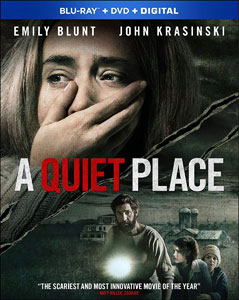“A Quiet Place” – now available for digital purchase and hitting rental/streaming July 10 – doesn’t mess around. It throws us smack dab into a post-apocalyptic world where a family is in danger from monsters that hunt by sound. Tragedy befalls them before the opening title card. What follows is, if you look at any given scene, nothing new – although director/co-writer/star John Krasinski (“The Office”) knows how to deliver tension and scares – but the overall 90-minute riff forces the viewer to see the world in a new way.
Assisted by Bryan Woods and Scott Beck on the script, Krasinski’s pet project is about a farm family trying to survive. As mom Evelyn, Emily Blunt gives the most robust performance, particularly when she’s in the impossible situation of having to give birth without making a sound. As dad Lee, Krasinski hides behind his beard, sad but not totally resigned. In a basement lab in the neighbor’s abandoned house, he mulls over the creatures and defense strategies.
Millicent Simmonds, as daughter Regan, has one of those wise faces wherein she’ll look the same at 40 as she does at 14. Regan wears a hearing aid of dubious worth (although, frankly, being deaf isn’t all that much of a handicap in this dystopia). Rounding out the family is son Marcus (Noah Jupe). Lee is training both kids to live in this reality, but he gives more time to the younger Marcus, which causes tension.
“A Quiet Place” might garner awards for sound design just because it’s so unusual. This is a movie you could watch with your parents – assuming they like horror movies – without having to worry about whether it’s loud enough for them. There’s not much spoken dialog. However, when we do get the tense score, refreshing sounds of nature, or a rare instance of diagetic music – Evelyn and Lee sharing a country ballad via earbuds – it’s a revelation.
Also deserving credit are the creature designers. It’s not easy to come up with a monster that is functionally all ear, yet scary rather than silly. They achieve it.
What’s most unusual about “A Quiet Place” is that we absorb its biggest messages after the ride rather than during it. We realize the Abbott family is specially equipped to survive because they are farmers – perhaps even subsistence farmers – and their daughter is deaf, or at least close enough to deaf that everyone in the family knows sign language.
This might be a case of me bringing my own subtext, but I think “A Quiet Place” is saying something with the fact that – as far as we can tell – almost the entire population of Earth has been wiped out in less than a year by a handful of beasts that hunt via noise. In other words, people can’t live quietly and simply even if their lives depend on it. We’ve become bulls on the china shop of the planet so gradually that we don’t realize how absurd we are.

Granted, the film does not overtly make that statement. It doesn’t overtly do much of anything, and – counter-intuitively – that makes it more satisfying than last year’s “It Comes at Night,” which is in the same subgenre: A monster hunts survivors after an unexplained apocalypse. That film peppers in enough cryptic hints about the cause of the apocalypse that, by the time it ends, I wanted answers. In retrospect, it never intended to give those answers – it just wanted to be a family survival film – but it overplays its hand and pushes a viewer into thinking about the wider mystery.
There’s a vibe to Krasinski’s film that calls to mind M. Night Shyamalan’s “Signs” and “The Village,” as well as Stephen King’s “The Langoliers” for the way the monsters devour the past (although not quite so literally here). But by some subtle touch, I could tell “A Quiet Place” doesn’t intend to be more than what it is: An artistic horror film with a likable family that makes us rethink how we use our five senses.

